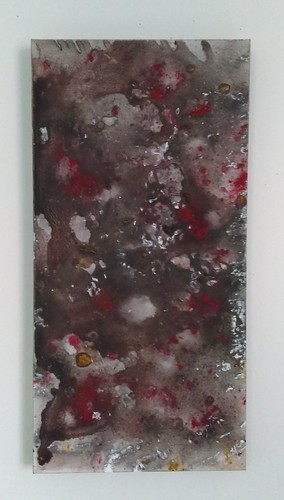growth. The structure of LecB in complex with its monosaccharide ligands L-fucose and D-mannose was determined by X-ray crystallography. Since the unusual strong interaction of L-fucose with LecB and the approximately 150-fold weaker interaction of D-mannose was reported first by Gilboa-Garber et al., numerous fucosides were examined as LecB inhibitors due to the potency of this binding. Recently, we reported on terminally modified mannosides as potent LecB inhibitors with low micromolar binding affinities. In order to further improve LecB inhibitors as therapeutics against chronic P. aeruginosa infections, we consider a detailed understanding of the contributions of the individual pharmacophores or functional groups in fucosides and mannosides to the overall binding affinity to be essential. The interaction of LecB with its natural ligands, fucosides and mannosides is mediated by two Ca2+ ions in the binding site, which coordinate the ligand though their 2-, 3- and 4-hydroxy groups. Furthermore, an additional lipophilic contact of the equatorial methyl group in fucosides served as an explanation for their unusual high affinity. Interestingly, although mannosides form an additional hydrogen bond via O-6 with Ser23 in the crystal structure, they are much weaker ligands for LecB in solution. To elucidate the individual contributions of the lipophilic interaction of the C-6 methyl group in methyl a-L-fucoside and the hydrogen-bond forming hydroxymethyl group in methyl MedChemExpress MK 886 a-D-mannoside to binding with LecB, a distinct set of derivatives was synthesized and their interactions with LecB characterized. By using a competitive binding assay  and thermodynamic techniques, the contribution of these substituents to the binding affinity was quantified. Theoretical analyses using molecular dynamics simulations and predictions of free energies of binding revealed a destabilization of a hydrogen-bonding network of Asp96 in LecB, resulting from steric hindrance in mannose-derived ligands, as molecular basis for the increased binding affinity of fucosides over mannosides. Experimental Chemical Syntheses Nuclear magnetic resonance spectroscopy was performed on a Bruker Avance III 400 UltraShield spectrometer at 400 MHz or 101 MHz. Chemical shifts are given in ppm and were calibrated on residual solvent peaks as 2 / PubMed ID:http://www.ncbi.nlm.nih.gov/pubmed/19690518 22 Molecular Basis of Monosaccharide Selectivity of LecB internal standard. Multiplicities were specified as s, d, t or m. The signals were assigned with the help of 1H,1HCOSY, DEPT-135-edited 1H,13C-HSQC and 1H,13C-HMBC experiments. High resolution mass spectra were obtained on a Bruker micrOTOF II ESI spectrometer and the data were analyzed using DataAnalysis from Bruker. HPLC was performed on a Shimadzu HPLC system. Thin layer chromatography was performed using silica gel 60 coated aluminum sheets containing fluorescence indicator using UV light and by charring either in anisaldehyde solution, in aqueous KMnO4 solution or in a molybdate solution with heating. 3 / 22 Molecular Basis of Monosaccharide Selectivity of LecB Medium pressure liquid chromatography was performed on a Teledyne Isco Combiflash Rf200 system using pre-packed silica gel 60 columns from Teledyne Isco, SiliCycle or Macherey-Nagel. PubMed ID:http://www.ncbi.nlm.nih.gov/pubmed/19691550 Commercial chemicals and solvents were used without further purification. Methyl a-D-mannoside was purchased from Sigma Aldrich, L-fucose from Dextra Laboratories, methyl b-D-arabinoside from TCI Europe, methyl a-L-fucoside and methyl b-L-fucoside fr
and thermodynamic techniques, the contribution of these substituents to the binding affinity was quantified. Theoretical analyses using molecular dynamics simulations and predictions of free energies of binding revealed a destabilization of a hydrogen-bonding network of Asp96 in LecB, resulting from steric hindrance in mannose-derived ligands, as molecular basis for the increased binding affinity of fucosides over mannosides. Experimental Chemical Syntheses Nuclear magnetic resonance spectroscopy was performed on a Bruker Avance III 400 UltraShield spectrometer at 400 MHz or 101 MHz. Chemical shifts are given in ppm and were calibrated on residual solvent peaks as 2 / PubMed ID:http://www.ncbi.nlm.nih.gov/pubmed/19690518 22 Molecular Basis of Monosaccharide Selectivity of LecB internal standard. Multiplicities were specified as s, d, t or m. The signals were assigned with the help of 1H,1HCOSY, DEPT-135-edited 1H,13C-HSQC and 1H,13C-HMBC experiments. High resolution mass spectra were obtained on a Bruker micrOTOF II ESI spectrometer and the data were analyzed using DataAnalysis from Bruker. HPLC was performed on a Shimadzu HPLC system. Thin layer chromatography was performed using silica gel 60 coated aluminum sheets containing fluorescence indicator using UV light and by charring either in anisaldehyde solution, in aqueous KMnO4 solution or in a molybdate solution with heating. 3 / 22 Molecular Basis of Monosaccharide Selectivity of LecB Medium pressure liquid chromatography was performed on a Teledyne Isco Combiflash Rf200 system using pre-packed silica gel 60 columns from Teledyne Isco, SiliCycle or Macherey-Nagel. PubMed ID:http://www.ncbi.nlm.nih.gov/pubmed/19691550 Commercial chemicals and solvents were used without further purification. Methyl a-D-mannoside was purchased from Sigma Aldrich, L-fucose from Dextra Laboratories, methyl b-D-arabinoside from TCI Europe, methyl a-L-fucoside and methyl b-L-fucoside fr